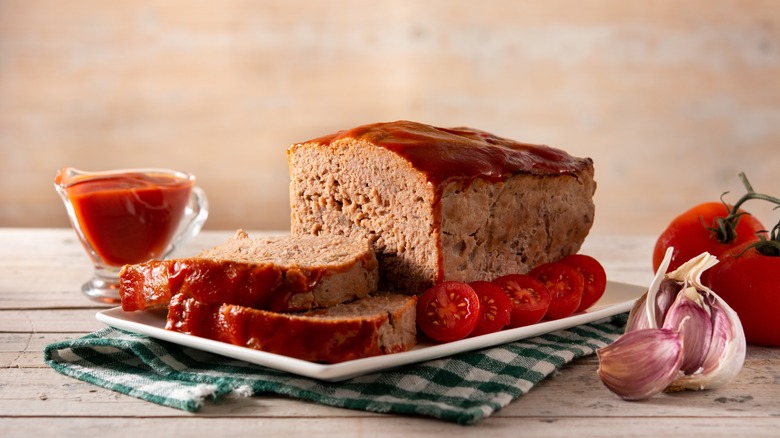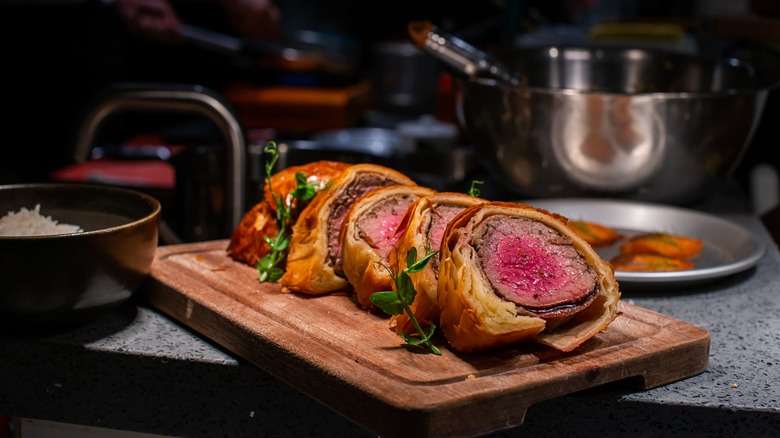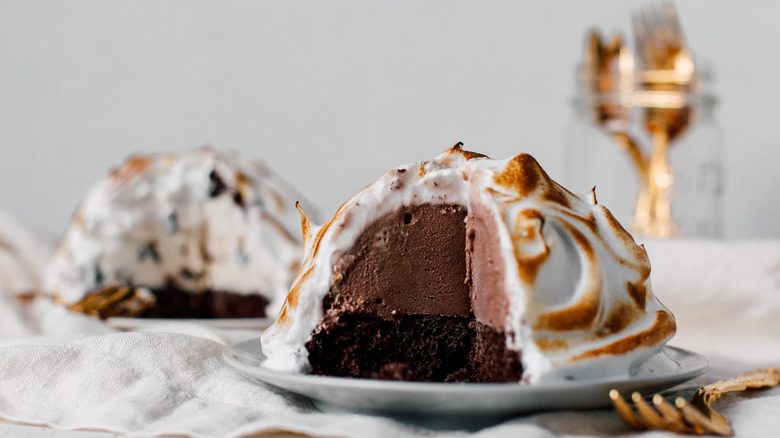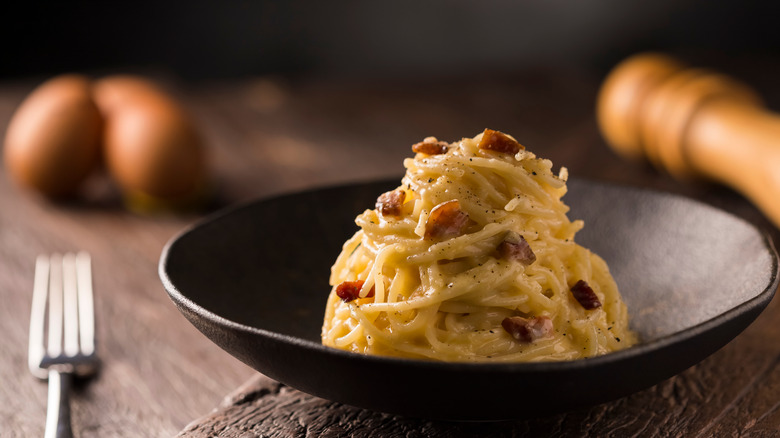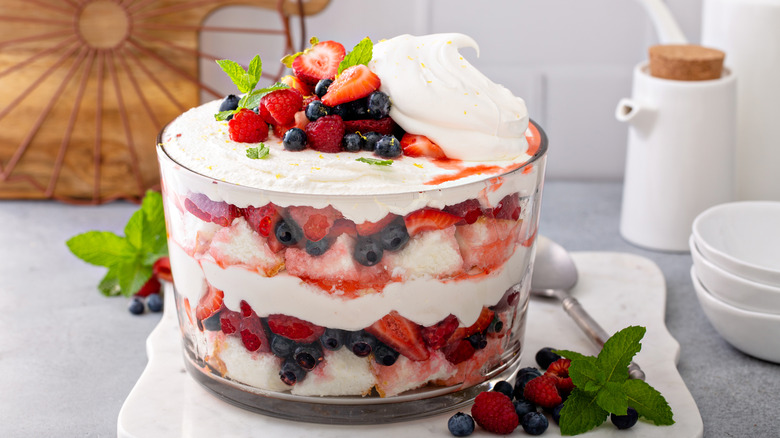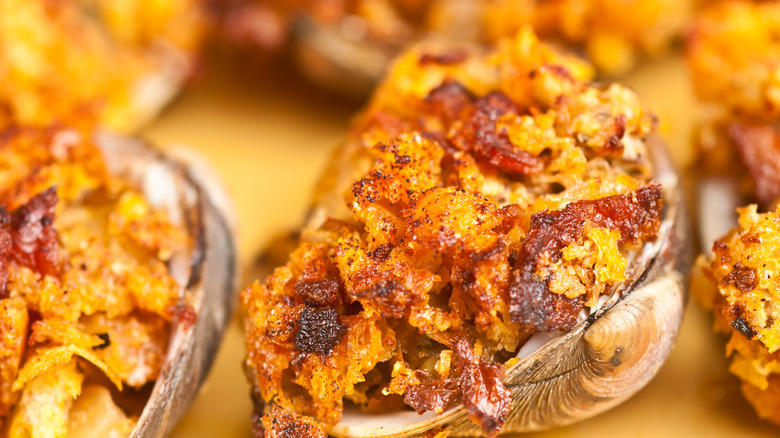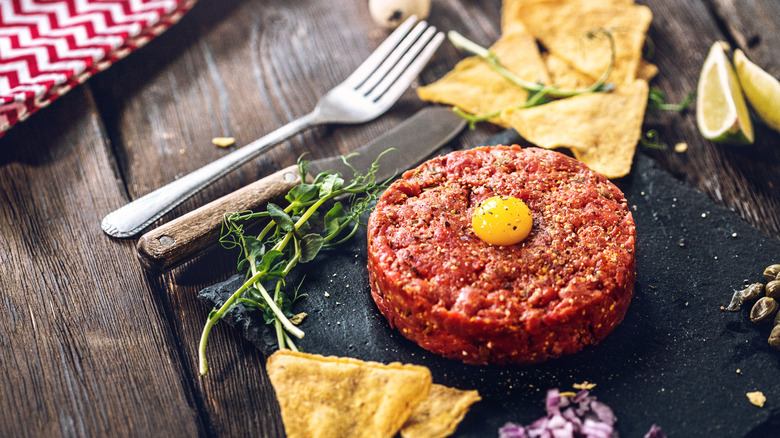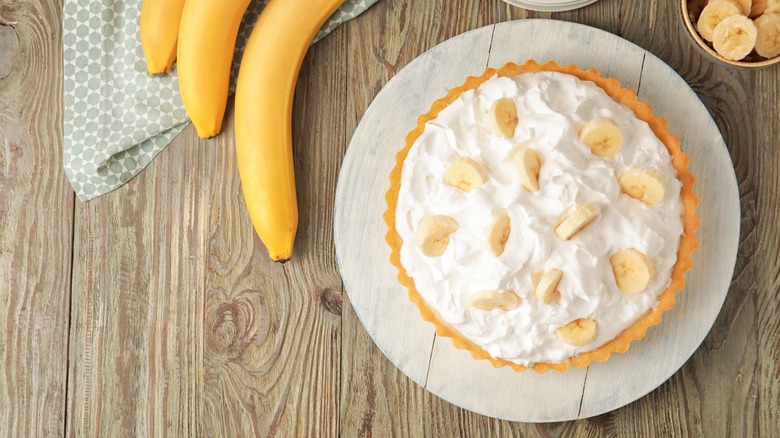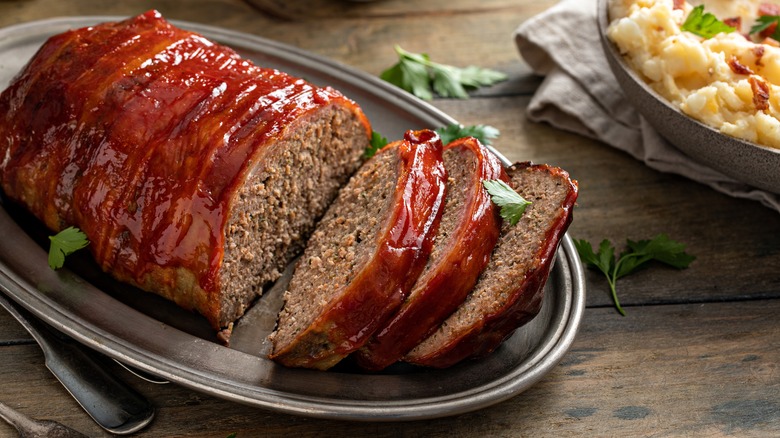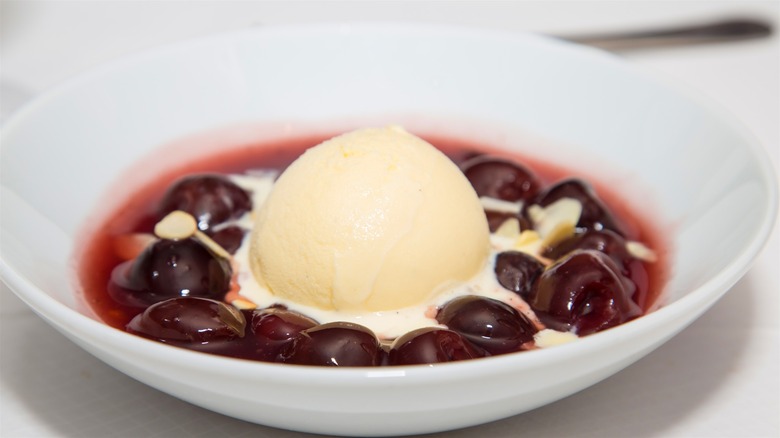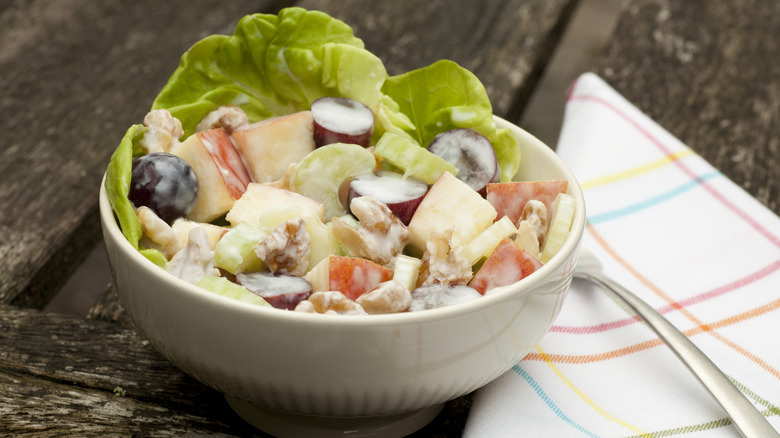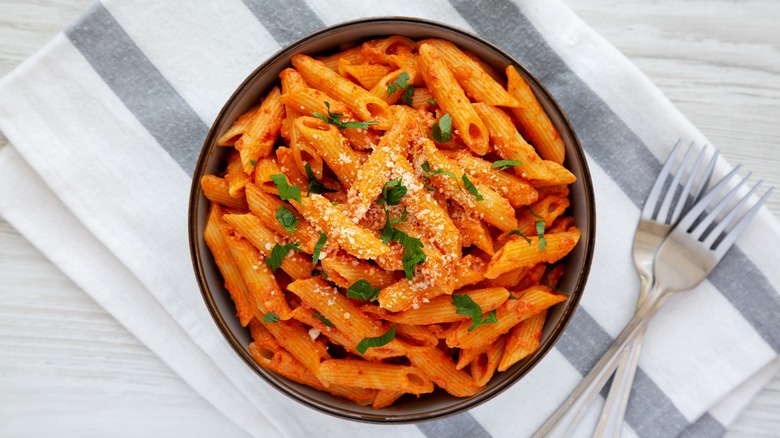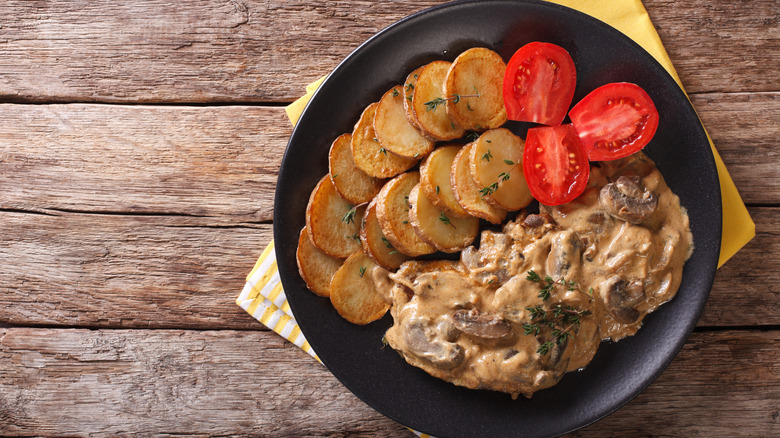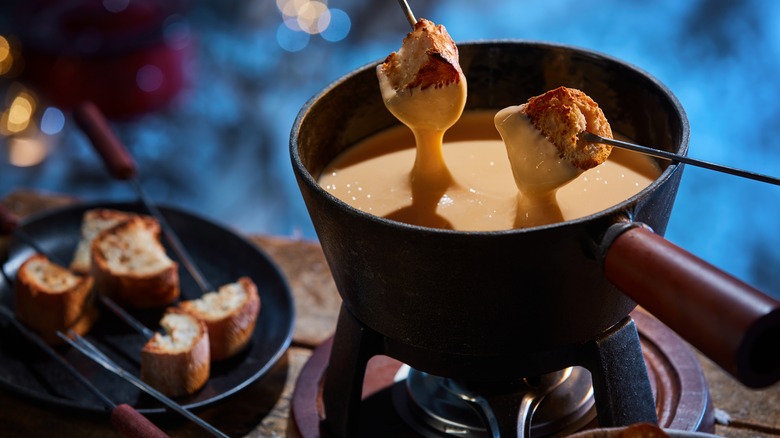13 Old-Fashioned Restaurant Dishes Chefs Love That Need To Make A Comeback
We live in an age of nostalgia. From reboots on TV to the resurgence of Y2K fashion, the past is having a moment, and the food world is not immune. Cottage cheese, Jell-O, and even Spam have been enjoying a revival in popularity, while fast food chains have been going back to their roots with retro packaging. You don't have to make special trips to fast food joints or the store to take part in the trend, either. There are plenty of recipes that will remind you of your childhood that you can make at home with the ingredients that are probably already on your pantry shelves.
In the fine dining world, however, innovation is everything, and it can be hard to find retro classics no matter how delicious they are. Luckily, some influential chefs have come forward to champion once-popular dishes that deserve to make a comeback. From a raw meat and egg dish approved by Alton Brown to a pasta dish favored by disco-goers in the '80s, here are some of the old-fashioned recipes that should be featured on fine dining menus again.
1. Beef Wellington
You can tell just by its classically British name that Beef Wellington is an old-fashioned dish. Named after the newly-appointed Duke of Wellington, Arthur Wellesley, in 1815, it was made to celebrate his victory over Napoleon Bonaparte in the Battle of Waterloo. The dish is made by coating a beef filet or tenderloin in mustard, wrapping it in either foie gras or thinly chopped mushrooms with herbs (called mushroom duxelles), and encasing it in puff pastry. The result is a flaky golden cylinder with striking concentric circles of color bursting with salty, rich flavor.
The dish has been a classic of English cuisine for more than two centuries, but enjoyed its heyday in the U.S. in the mid-20th century when Julia Child popularized it on her cooking show "The French Chef." Richard Nixon was also a fan, insisting that it be served at state dinners. In the ensuing decades, however, Beef Wellington has become associated with this specific era in American history and has taken on an incontrovertibly retro status. And yet, it has its champions. Gordon Ramsay is known for his love of the dish, identifying it as one of his all-time favorite main courses and a dish that would definitely be on his last supper menu. So, the next time you're pondering which show-stopping recipe to produce for your next celebration, imagine Ramsay shouting in your ear about Beef Wellington, and you'll know exactly how to proceed.
2. Baked Alaska
Frozen desserts were all the rage in the 1800s, and none was as vaunted as the Baked Alaska. Comprised of a cake covered in ice cream encased in meringue, it was a symbol of decadence and cutting-edge refrigeration. Thomas Jefferson is said to have adored an early approximation that consisted of ice cream covered in a pastry shell, but the most popular origin story has to do with America's acquisition of its northernmost state. To celebrate the Alaska Purchase in 1867, the ritzy New York restaurant Delmonico's, presented the dessert to patrons, drawing on recipes like the one Jefferson favored.
The frozen dessert may no longer be as popular as it was in the late 1800s, but there is nothing inherently outdated about it. With a cold, creamy interior, a bed of sponge cake, and a visually arresting meringue shell, it is just as impressive and delicious as it was more than a century ago. Despite its flagging popularity, some chefs have made a point of featuring it on their menus. Daniel Boulud, the French chef and restaurateur with restaurants throughout the U.S., including the Michelin-starred Daniel in New York, has made Baked Alaska his signature dish. For the fifth anniversary of one of his restaurants, he even presented a 7-foot version, producing a blowtorch to perfectly flambé the meringue as onlookers gathered around to take photos.
3. Pasta carbonara
Pasta never goes out of style. Full of delicious carbs and plenty of cheese, it is the kind of dish that will delight just about anyone, from picky six-year-olds to snobby sixty-year-olds who delight in culinary elitism. With its creamy egg-based sauce, salty pieces of guanciale or bacon, and a generous portion of parmesan, pasta carbonara is a classic within a classic category, providing all the cheesy indulgence and saltiness you can wish for. Its origins may date back either to Naples in the 1800s or Rome in the 1940s when eggs and bacon were some of the few ingredients that cooks had at their disposal. Its popularity surged in the 1950s as Italian food became popular in the U.S., but its place on fine dining menus has all but evaporated.
Many pasta dishes deserve to grace the tables of the finest restaurants in the world, but carbonara should be at the top of the list. It may not be complicated to prepare or feature obscure, pricey ingredients, but when made well, it is flawless. Creamy, salty, and elegantly simple, it's no wonder it's one of Rachael Ray's signature dishes and the one her husband insists on having for his birthday every year.
4. Trifle
Classic English trifles date all the back to the Renaissance when they consisted of sponge cake soaked in wine or spirits and served with custard and whipped cream. Eventually, they became a handy way to use up stale cake and usually included fruit as well. The dessert gained particular popularity in restaurants in the U.K. after World War II, becoming synonymous with the era. In the U.S., it was a Southern staple in the 1970s, when cloud-like desserts served in cut glass bowls like ambrosia salad and Watergate salad were considered the height of sophistication.
Not all chefs have relegated trifle to the cringe-worthy past, however. Jamie Oliver embraces the dessert's old-fashioned reputation, publishing his mom's retro trifle recipe and saying that it conjures memories of his childhood. One of the reasons Oliver is so effusive in his praise is that trifles are adaptable and accessible. You can buy all the ingredients ready-made, including custard, whipped cream, and jelly, or you can make the custard yourself, whip fresh cream, and concoct your own jam. Rich but somehow light and airy, this dessert tastes like summer and is one of the best ways to use up leftover cake.
5. Clams casino
Clams cooked in butter and topped with toasted bacon and breadcrumbs constitute the classic dish known as clams casino. It's delicious and indulgent (just as anything with bacon is) and has a tinge of classiness to it thanks to the clams. In New England, it's an integral part of the regional culinary scene, but outside this part of the U.S., it's nowhere near as popular as it once was. Named after the incongruously named Narragansett Pier Casino in Rhode Island, which was a hotel and resort rather than a gambling establishment, the dish was beloved in the early 1900s, but is now mostly relegated to coastal New England restaurants serving traditional fare.
Though it is not a mainstream dish around the country anymore, it doesn't take much digging to find passionate proponents of clams casino. Chef John Mitzewich (known as "Chef John" to his millions of YouTube subscribers), describes the dish as one of his all-time favorites and "pure food porn on the half shell." Meanwhile, "Chopped" judge Scott Conant has talked about making dozens of them every night during his first restaurant job and the fond memories they conjure (via YouTube).
6. Steak tartare
At face value, a dish made of raw eggs and raw beef might sound like a recipe for disaster, but in practice, steak tartare is a French classic that chefs have been fawning over for more than a century. Created in the late 19th century in France using raw beef, raw egg yolk, mustard, capers, and other seasonings, it became popular in the U.S. in the 1950s, perhaps due to the surge in demand for French cuisine. Its star faded, possibly as a result of growing concerns over foodborne illnesses following various outbreaks including the 1993 undercooked Jack in the Box scandal that led to an overhaul of the U.S.D.A.'s food safety inspection system.
When made with carefully sourced ingredients, however, steak tartare is every inch the delicacy it was back in the late 19th and early 20th centuries. With a subtle flavor and tender texture, it has a similar appeal to ceviche, but with even more nuance thanks to the lack of fishiness. Alton Brown calls it "hands down my favorite dish of all time," and assures skeptics that when handled and prepared correctly, the meat poses minimal risks (via AltonBrown.com).
7. Banana cream pie
These days, it would be strange to walk into the produce section of a grocery store and find that there were no bananas. The fruit is so popular that Americans eat about 26 pounds per person a year (per Statista). But back at the turn of the 20th century, bananas were a novelty, a fruit that still had a tinge of the exotic about it and which chefs and home cooks were still learning how to incorporate into their meals. Banana cream pie emerged as one of the better options. Made with pastry cream and sliced bananas and topped with whipped cream, this classic concoction is rich, sweet, and full of banana flavor without going overboard. Its popularity may have peaked over a century ago, but the formula is just as delicious as ever.
One of the champions of the creamy dessert is Emeril Lagasse, whose larger-than-life onscreen presence, breadth of recipes, and enthusiasm for the culinary arts have been delighting audiences for decades. In all his many recipes, however, his banana cream pie stands above the rest. The chef has become famous for his rich, velvety take on the old-fashioned dessert, first publishing a recipe in his 1993 cookbook "New New Orleans Cooking" and continuing to adapt it ever since.
8. Meatloaf
If you were asked to think of the quintessential retro recipe, chances are you'd think of meatloaf. The recipe that we know (and maybe even love) today emerged in the early 20th century, and became a baked-in part of the country's culinary heritage during the Great Depression and World War II when meat scraps and crushed cereal were the best ingredients that many households could afford. Once the financial outlook of the country began to pick up, meatloaf was a beloved comfort food that home cooks and restaurants continued to produce despite the availability of more upmarket ingredients.
These days, the dish has been demoted to a culinary curiosity of yesteryear, the kind of recipe you might serve ironically or as a nostalgic meal that conjures memories of your grandparents. But some chefs are not afraid to tout the merits of this hopelessly old-fashioned dish. According to Jamie Oliver, meatloaf is comfort food at its very best, and a dish that he and his family love. Chef Jean-Pierre, who frequently shares his exuberance for cooking on "The Food Network" and "The Today Show," has a famous recipe that he served in his restaurant in Florida in the 1970s. It was so popular, he claims, that guests would line up outside before the restaurant opened to order their portion.
9. Cherries Jubilee
1897 marked the 60th anniversary of the reign of Queen Victoria. To commemorate the event, known as the "Diamond Jubilee," renowned chef Auguste Escoffier created a dessert made with one of the Queen's favorite fruits. Cherries Jubilee is a simple concoction with an impressive flourish. All you have to do is stew fresh cherries with lemon juice and sugar until it thickens, add high-proof alcohol, light it on fire, and pour it over ice cream once the flame has subsided. It's the sort of dessert that would astonish even one of the most powerful monarchs in the world but is actually fairly easy to make.
In the 1950s and '60s, Cherries Jubilee was a staple of fine dining establishments, where chefs in white hats would wow their audiences with the open flame. It rarely appears on restaurant menus now, but it does have a few powerful proponents. Wolfgang Puck, for example, has his own take on the recipe in which he calls for sautéing the cherries in butter and caramelized sugar instead of stewing them. Chef and cookbook author Claire Saffitz has also championed the dish, advocating the use of bourbon in order to mimic the flavors of an Old Fashioned cocktail.
10. Waldorf Salad
Though it can be hard to uncover the precise origins of old-fashioned dishes, the origin of the Waldorf salad is easy. It made its debut on March 14th, 1893 at the Waldorf Hotel in New York, and was created by the hotel's chef Edouard Beauchamp and its celebrity maître d'hôtel Oscar Tschirky. In its original form, it was nothing more than apples and celery dressed in mayonnaise. Over time, however, it was adapted in countless ways. Some versions reimagined it as a purely sweet concoction made with mandarin oranges and marshmallows, while the Waldorf's own recipe morphed into something more sophisticated and savory, with a dressing made of mustard, olive oil, champagne vinegar, egg yolk, and white truffle oil. Even Jell-O jumped on the bandwagon, creating the so-called New Manhattan Salad made of apples, celery, and walnuts suspended in lemon Jell-O and flavored with vinegar. Yum. Out of all these variations, the main components that have stood the test of time are apples, grapes, walnuts, and celery tossed in a mayonnaise dressing.
The salad was a popular feature of fine dining restaurants and suburban kitchens throughout the first half of the 20th century, but lost its luster as chefs began to favor lighter, fresher ingredients. As Chef John from "Food Wishes" points out, it is "a triumph of taste and texture" that has earned its place as one of the few fruit salads that has its own name.
11. Penne alla vodka
Many of the dishes that enjoyed a surge in popularity in the 20th century were the darlings of either mid-century housewives or upscale New York restaurants. For penne alla vodka, however, it was disco clubs that led to fame. The recipe might have been invented by a Bolognese chef, a Queens housewife, or a student at Columbia University, but it gained popularity as a nightclub meal in the 1980s. A simple combination of penne tossed in a velvety sauce of tomatoes, vodka, and cream, this dish is so heavenly that, according to Rachael Ray, her viewers used to send her letters claiming to have gotten engaged shortly after serving it to their boyfriends. As a result, she restyled her version of the dish "You Won't Be Single For Long Vodka Cream Pasta."
Last time we checked, penne alla vodka is sadly no longer a common feature on nightclub menus, but it deserves to be brought back to restaurants of all levels of culinary excellence. On TikTok, Giada de Laurentiis calls the dish "heaven," and says she loves it because it's simple to make but "always feels so special and glamorous." So, if you can't find a restaurant that's serving this deliciously simple yet dazzling dish, you won't have to work very hard to make your own.
12. Steak Diane
In the 1930s, there was nothing quite as sophisticated as a chef standing tableside, igniting a plate of food in a burst of intentional flames. Flambéing was the ultimate sign of a classy establishment, and steak Diane was the classiest recipe for the job. Made with a tender filet mignon dressed in a decadent sauce of Cognac, cream, shallots, and pan drippings, it was popular throughout the '40s and '50s, and was often prepared in front of diners with the all-important fiery denouement.
The dish lost its luster by the end of the 20th century, but its formula remains flawless. A choice cut of beef covered in a creamy sauce that you get to set on fire? Sign us up. Chicago-based Michelin-starred chef and James Beard Award Semi-Finalist John Shields demonstrated just how sorely this dish deserves an upscale comeback when he added it to the menu of his restaurant The Loyalist in 2022, calling it "rich, indulgent[,] and deeply satisfying with every bite" (via InsideHook).
13. Fondue
If you attended a party or went to a restaurant in the 1970s, you certainly got to enjoy the delicacy of the era: fondue. Serving a vat of melted cheeses with cubes of skewered bread for dipping was practically mandatory around this time, but the recipe dates back much further. Homer's "Iliad" name-checks a recognizable version of the gooey creation made with goat or sheep cheese, wine, and flour. In more recent centuries, it was the almost exclusive purview of the Alps, where a hot mixture of aged cheese, wine, and flour was not only delicious and warming, but also practical during seasons when other food sources were scarce. When the Swiss introduced their national dish to Americans at the 1964 World's Fair, it was a sensation. Several decades later, however, it's gone the way of rotary phones and popcorn ceilings.
And yet, it's hard to ignore the appeal. Pretty much everyone loves cheese, especially when it's melted, and when you turn that into a collaborative experience akin to roasting marshmallows, it's a winning formula. Chefs like Andrew Zimmern aren't afraid to stick their necks out for the dish. "I happen to love fondue," the celebrity chef swooned in a 2021 tutorial on YouTube, explaining that like other products of the '70s, it's ready for a comeback. With the ever-expanding access to different varieties of cheese in the U.S., its potential is greater than ever.
